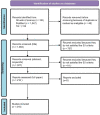State of the art and future directions in assessing the quality of life in rare and complex connective tissue and musculoskeletal diseases
- PMID: 36213631
- PMCID: PMC9537631
- DOI: 10.3389/fmed.2022.986218
State of the art and future directions in assessing the quality of life in rare and complex connective tissue and musculoskeletal diseases
Abstract
Background: As chronic conditions, rare and complex connective tissue and musculoskeletal diseases (rCTDs) significantly affect the quality of life generating an impact on the physical, psychological, social, and economic dimensions of the patients' lives, having implications on the family, changing the lifestyle and interpersonal relationships. Traditionally, generic and disease-specific measures for Quality of Life (QoL) provide valuable information to clinicians since QoL affects healthcare services utilization, predicts morbidities and mortalities, workability, etc. Moreover, the assessment of unmet clinical needs, satisfaction, the experience with the treatment and the care, the psychological dimensions, and the effects of the diseases, such as fatigue, could represent valuable dimensions to be considered in the QoL impact assessment. It is also necessary to measure the impact of rCTDs by considering the perspectives of family members/informal caregivers, for instance considering values, beliefs, experiences, life circumstances, psychological aspects, family relationships, economic issues, changes in social activities, etc.
Objective: The aim of this scoping review is to better understand the status of QoL metrics used in clinical and economic research for the assessment of the individual's perspective on living with rCTDs.
Research question: What are the main challenges in QoL measures (and/or) measurement/assessment in rCTDs?
Materials and methods: Scoping review of the literature referring to QoL measures in rCTDs. Database: PUBMED, ISI-Web of Science; last date: 21/09/2021.
Results: Anxiety and depression, body image satisfaction, daily activity, fatigue, illness perception, pain, personality, QoL, resilience, satisfaction with the relationship, self-management, sexual QoL, sleep quality, social support, stress, uncertainty, and work productivity are the observed dimensions covered by the included studies. However, "more shadows than lights" can summarize the review's outcome in terms of Patient Reported Outcome Measures (PROMs) domains covered for each of the rCTDs. Also, for those diseases characterized by a relatively high prevalence and incidence, such as Systemic Lupus Erythematosus, Sjögren's Syndrome, and Systemic Sclerosis, the analysis of patients' resilience, satisfaction with the quality of the relationship, personality, and stress are still missing dimensions. It has been observed how reducing items, increasing the number of domains, and disease-specific questionnaires characterize the "technological trajectory," such as the evolution of questionnaires' characteristics for assessing QoL and QoL-related dimensions and the burden of rCTDs.
Conclusion: The scoping review presents an overview of studies focused on questionnaires used to evaluate the different dimensions of quality of life in terms of general instruments and disease-specific questionnaires. Future research should include the co-design with patients, caregivers, and patient representatives to create questionnaires focused on the unmet needs of people living with rCTDs.
Keywords: PROMS; daily activity; fatigue; musculoskeletal diseases; pain; quality of life; rheumatic diseases; sleep quality.
Copyright © 2022 Trieste, Cannizzo, Palla, Triulzi and Turchetti.
Conflict of interest statement
The authors declare that the research was conducted in the absence of any commercial or financial relationships that could be construed as a potential conflict of interest.
Figures





Similar articles
-
Palliative care experiences of adult cancer patients from ethnocultural groups: a qualitative systematic review protocol.JBI Database System Rev Implement Rep. 2015 Jan;13(1):99-111. doi: 10.11124/jbisrir-2015-1809. JBI Database System Rev Implement Rep. 2015. PMID: 26447011
-
The impact of psoriatic arthritis on quality of life: a systematic review.Ther Adv Musculoskelet Dis. 2024 Dec 22;16:1759720X241295920. doi: 10.1177/1759720X241295920. eCollection 2024. Ther Adv Musculoskelet Dis. 2024. PMID: 39717741 Free PMC article. Review.
-
Behavioural modification interventions for medically unexplained symptoms in primary care: systematic reviews and economic evaluation.Health Technol Assess. 2020 Sep;24(46):1-490. doi: 10.3310/hta24460. Health Technol Assess. 2020. PMID: 32975190 Free PMC article.
-
Burden and quality of life in caregivers of persons with multiple sclerosis.Neurol Neurochir Pol. 2012 Sep-Oct;46(5):472-9. doi: 10.5114/ninp.2012.31358. Neurol Neurochir Pol. 2012. PMID: 23161192 Review.
-
The future of Cochrane Neonatal.Early Hum Dev. 2020 Nov;150:105191. doi: 10.1016/j.earlhumdev.2020.105191. Epub 2020 Sep 12. Early Hum Dev. 2020. PMID: 33036834
Cited by
-
Effectiveness of physical activity interventions on reducing perceived fatigue among adults with chronic conditions: a systematic review and meta-analysis of randomised controlled trials.Sci Rep. 2023 Sep 4;13(1):14582. doi: 10.1038/s41598-023-41075-8. Sci Rep. 2023. PMID: 37666869 Free PMC article.
-
The Role of Exercise to Improve Physiological, Physical and Psychological Health Outcome in Idiopathic Inflammatory Myopathies (IIM).J Inflamm Res. 2024 Jun 5;17:3563-3585. doi: 10.2147/JIR.S377102. eCollection 2024. J Inflamm Res. 2024. PMID: 38855165 Free PMC article. Review.
References
-
- Talarico R, Aguilera S, Alexander T, Amoura Z, Andersen J, Arnaud L, et al. The added value of a European reference network on rare and complex connective tissue and musculoskeletal diseases: Insights after the first 5 years of the ERN ReCONNET. Clin Exp Rheumatol. (2022) 40:3–11. 10.55563/clinexprheumatol/d2qz38 - DOI - PubMed
Publication types
LinkOut - more resources
Full Text Sources
Research Materials

